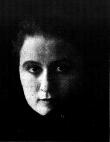Ida Dorothy Otley Wilkinson was born on 16 July 1902 at Picton, New South Wales, to Australian-born parents, Ida Constance, nee Fletcher and her husband, Walter Barwon Wilkinson, mine manager. When she was aged five, her parents moved to Ballarat, Victoria, where at only six years of age, Dorothy contracted poliomyelitis and was thereafter confined to a wheelchair. Following the separation of her parents, she was raised by her grandmother at Picton and later at Toowoomba, Queensland. She also spent time on her Fletcher uncles' stations, Elmina, near Charleville, and Ularunda, near Morven, where she taught cattle dogs and sheep to draw her wheelchair. She was educated at home by governesses, and following her move to be with her Aunt Lavinia Fletcher in Sydney, she was taught by Theo Cowan, the female sculptor, and attended Dattilo Rubbo's classes at the Royal Art Society of New South Wales.
In 1920, Dorothy returned to live at Ularunda where she improved her shooting, swimming, and rowing, and soon learned to drive a car. She secretly married Walter Mackenzie Cottrell, a bookkeeper at Ularunda, at the Ann Street Presbyterian Church, Brisbane, on 23 May 1922. In February 1923, the couple 'eloped' to Dunk Island where they lived with the beachcomber and author Edmund Banfield and his wife Bertha Banfield. Later that year, the couple travelled to Sydney, living at the People's Palace, and Dorothy sold cartoons to several magazines. In 1924, they embarked on a life as tinkers travelling around New South Wales in a truck. That winter, they returned to Ularunda where, encouraged by Mary Gilmore, Dorothy started to write fiction.
In April 1927 the American Ladies' Home Journal bought the serial rights to a manuscript sent by Cottrell for $5000. It was later serialised between 24 October 1928 and 13 February 1929 in the Sydney Mail and also appeared in the English Women's Journal.
In 1928, it was published in London and Boston (1929) as The Singing Gold.
The Cottrells sailed for California on 19 October 1928 to avoid 'iniquitous taxation' on her American earnings. In 1930 she published Earth Battle (Tharlane in America), a tale of struggle to survive in the outback. The couple led a vagabond life in America where they took out citizenship in 1932. Whilst in Florida, Dorothy became a successful journalist and wrote short stories for magazines. She published two children's books, which, like much of her fiction, followed Australian themes, one of which, Australian Orphan, was made into a film. At the start of 1940, her writing was interrupted by a serious back injury.
Dorothy had a passion for the Caribbean. Her last published novel, The Silent Reefs, a mystery adventure, is set there. It was serialised in the Saturday Evening Post and filmed in 1959. As she commented, her wanderlust spirit interfered with her fictional output: she once returned to Florida in a 24 ft (7.3 m) ketch.
The Cottrells returned to Australia to manage Ularunda in 1954 where they remained until 1956 when they returned to Florida. There Dorothy died of heart disease on 29 June 1957. She was survived by her husband and their adopted son.
 157296029439475996.jpg
157296029439475996.jpg
